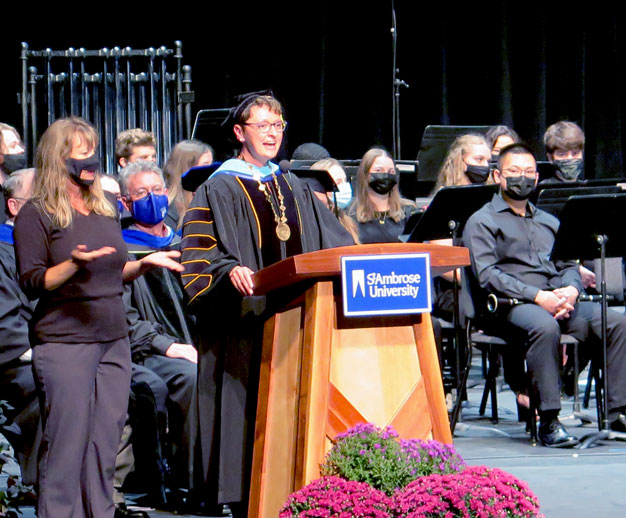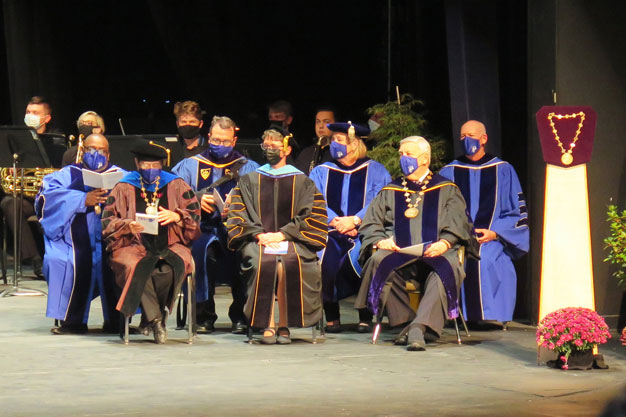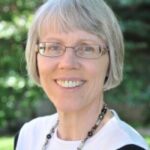
St. Ambrose University President Amy Novak gives her address after being installed as the 14th president of the university in Davenport Oct. 1 in Galvin Fine Arts Center on campus. Her theme is “Come to the Table.”
By Barb Arland-Fye
The Catholic Messenger
DAVENPORT — The inspired artwork of a long deceased priest/educator/ artist helped set the St. Ambrose University table that drew the university’s new president, Amy Novak, to respond “absolutely” when asked to accept her new leadership role. Her inauguration Oct. 1 on campus made ample use of the table as a metaphor of inclusivity and welcome, grounded in the radical hospitality of Jesus Christ.
Guests at Novak’s inauguration luncheon found a prayer card at their place on the table featuring a painting of the universal Christ, a Black child sitting on his Caucasian mother Mary’s lap. The late Father Edward Catich, a graduate of then-St. Ambrose College who later established its art department, created the “Theophora Icon.” The artwork captivated Novak when she saw it on campus and solidified her decision to accept the president’s post, she told the luncheon guests.The prayer card reads, “God of Grace, we come before you to seek your divine wisdom as we set our table to be a center of warmth, strength, and growth for all. Guide us as we strive to embody the words of Saint Ambrose of Milan: ‘Whether following the will of God or our bond with nature, let us be a help to each other.’ In Christ’s name we pray, Amen.”
Tables loomed large on inauguration day — the altar during Mass, the luncheon table at the noontime meal and reception tables outside the Rogalski Center. The podium from which she gave her inauguration address focused on the table.
‘She sees you as family’
“Welcome to the Ambrose Table,” she began, welcoming the people present for her installation as 14th president of St. Ambrose University. Among the guests were her predecessors, Sister Joan Lescinski, CSJ, and Edward Rogalski, and academic leaders representing universities across the country. Religious leaders representing Christians, Jews and Muslims attended as did business and political leaders. Faculty, staff and students were among the attendees and her parents, siblings, husband and eight children witnessed the ceremonies with pride.
She thanked all of them and singled out Ken, her husband of 28 years, “who sets the table each day alongside of me.” The love story she told spoke of their shared commitment to “see our relationship as a ministry committed to opening ourselves to the table of possibility.”
In a greeting to the gathering prior to her address, Ken spoke movingly of his love for his wife and her dedication to faith, family and the St. Ambrose University community she serves. “The reason she comes to work every day is because she sees you as family,” he said. “She has a place for you and for all who care for you inside her heart. She has expanded a space where the lines of welcome are wide and radical hospitality is practiced often.”
The new president chose “Come to the Table,” as the theme for inauguration day, describing the table as “the nerve center of a community. When I say ‘everything happens at the table,’ I mean to say we invite, we serve and we are nourished. We become vulnerable and share wisdom.” She provided humorous and reflective examples of table time in her family. “We pray, before the meal and after. We pray when we listen. We pray when we share. We laugh. A lot. We retell the stories of our lives.”
She asked the audience to think about the tables in their lives. “Your table is where you meet others, and when two or more are gathered in that sacred space of table, God is there as well,” she said. “Friends, the table is the place of communion; of conversation, conflict, or connection.

Amy Novak, center, waits to be installed as the 14th president of St. Ambrose University in Davenport. At left is retired President Sister Joan Lescinski, CSJ, and at right is retired President Edward Rogalski. The installation took place Oct. 1 in Galvin Fine Arts Center on campus.
The pilot project
His suggestion led to the pilot project that he and retired ag-businessman Tom Murphy of the Salina Diocese helped develop. “It’s a pilot project, we’re building it from scratch,” said Father Heina, who coordinates the project in his diocese. Currently, farmers in the Salina Diocese are mentors to farm managers of five projects in sub-Saharan Africa.
Farmers connect with the farmer managers via social media. Father Heina said the tricky part was convincing Kansas farmers that mentors and mentees learn from each other. “The mentor relationship depends on a genuine, personal interest to learn from the mentee.” It is about allowing the Holy Spirit to dwell within the relationship, the dialogue, he said. “Americans are hardwired to help, but not so good at recognizing how we can be helped. It takes a unique personality to be a mentor.” In addition, “We found it really helpful for the mentoring candidate to be a practicing Catholic.”
Father Heina’s presentation on Missio Invest to a local chapter of Catholic Rural Life intrigued Murphy, who led the chapter at the time. He said he and his wife, Jo, would be willing to step up. Murphy worked with Father Heina to develop the roles, responsibilities and expectations of farmer mentors.
Murphy took on the role of mentor himself, developing a prayerful, enriching relationship with Sister Mary Chilengwe in Zambia. “What that woman can do is nothing short of amazing,” says Murphy, a Deere & Co. retiree who once lived in Bettendorf and attended St. John Vianney Parish there.
Sister Mary runs a school, a convent and oversees a diverse farm that provides food and jobs for the people she serves. She and Murphy talk several times a month, sometimes a couple of times a week through text messages and even exchange short videos. Their relationship covers everything from troubleshooting challenges on the farm to praying for each other’s families.
“We share the joys and the hardships,” Murphy says. He helped Sister Mary to discover a new food source that she did not realize was growing on the farm, breadfruit, which can become a nutrient-rich flour. Farming techniques in sub-Saharan Africa are decades behind the U.S., so some of the problem solving involves great creativity, he added.
More farmer mentors needed
Murphy provides this “job description” for farmer/mentor candidates: a person with a desire to serve Christ through missionary outreach, a person with knowledge of ag production, a volunteer to be a mentor with specific ag projects in Africa, a person with leadership and communication skills via multimedia, a person who wants to make a difference.
The need for mentors extends beyond the five projects the Salina Diocese has taken on. “Missio Invest has approved 54 loans to date across eight countries. So far, only five of those projects have mentors. We issue approximately 20-30 new loans each year across the nine countries where we currently operate (Kenya, Uganda, Tanzania, Rwanda, Ethiopia, Nigeria, Ghana, Malawi, Zambia), Birge said.
That is where the Diocese of Davenport comes in. Ferris and Deacon Freeman, parish life coordinator of St. Mary Parish in Wilton and diocesan representative for Catholic Rural Life, worked with Father Heina and Murphy for guidance in tailoring a Missio Invest mentor project in the Davenport Diocese. Ferris and Deacon Freeman are enthusiastic about the project and hope to recruit farmers this fall to serve as mentors. Deacon Freeman noted that the Salina Diocese began its mentoring project focused on technical solidarity with the farm managers but shifted to relational solidarity. “You build relationships in order to help one another,” Deacon Freeman said.
“Our faith is so grounded in creation,” Ferris said. “Farmers get it.” He believes the project responds to the Laudato Si Action Platform that Pope Francis formally launched on the feast day of St. Francis to inspire Catholics and their institutions to review their impact on all of creation and to take action.
“This is an outlet for evangelization,” Deacon Freeman said. “It’s connecting and bonding in relationships. It’s showing that we care for one another.” Ferris adds, “It’s the sharing of gifts and of lives. That’s part of evangelization.”











